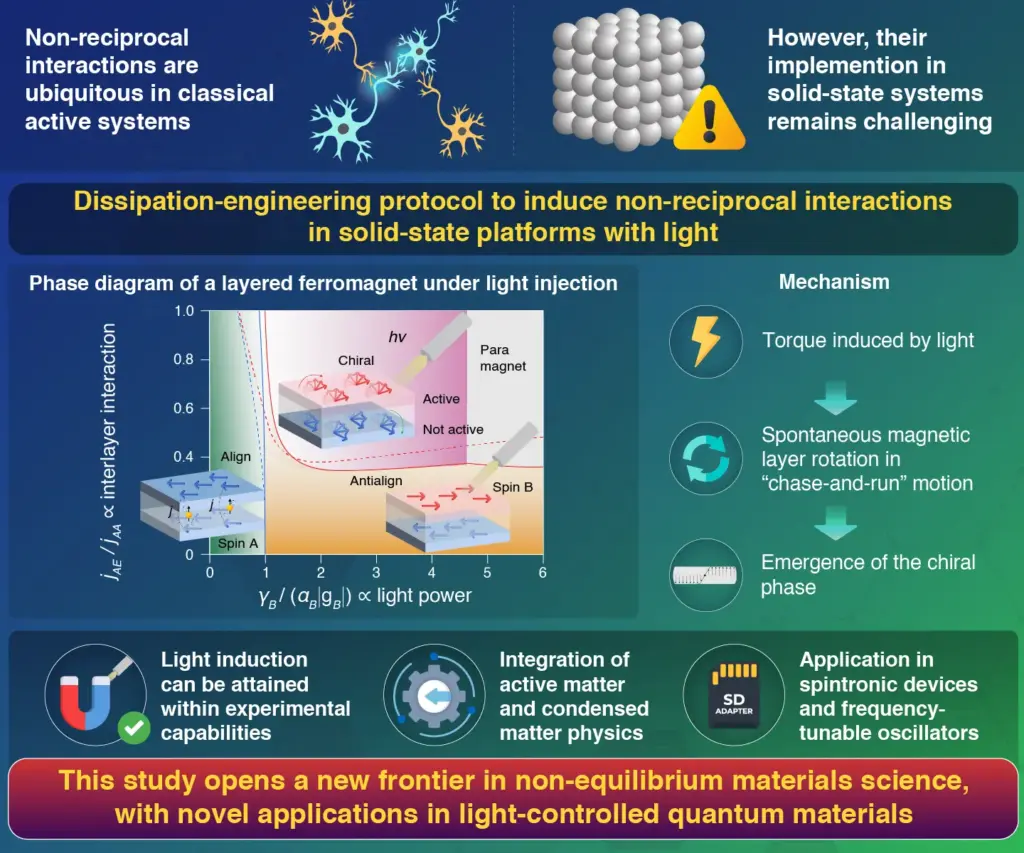
Researchers in Japan have unveiled a groundbreaking theoretical framework that predicts the emergence of non-reciprocal interactions in magnetic metals using light, effectively challenging Newton’s third law in solid-state physics. By irradiating light at a specific frequency onto a magnetic metal, the team demonstrated the induction of a torque that causes two magnetic layers to engage in a continuous “chase-and-run” rotation. This discovery opens new possibilities in the field of non-equilibrium materials science and suggests innovative applications for light-controlled quantum materials.
Understanding Non-Reciprocal Interactions in Solids
In traditional equilibrium systems, the law of action and reaction is a fundamental principle, ensuring that forces are balanced. However, in non-equilibrium systems such as biological entities or active matter, non-reciprocal interactions are commonplace. These interactions, which do not adhere to Newton’s third law, are evident in various natural phenomena, including the asymmetric dynamics between predator and prey and the interactions within optically active media.
The question of whether such non-reciprocal interactions can be replicated in solid-state systems has intrigued scientists for years. A team led by Associate Professor Ryo Hanai from the Institute of Science Tokyo, in collaboration with researchers from Okayama University and Kyoto University, has now provided an affirmative answer. Their findings, published in the journal Nature Communications, detail a method to induce non-reciprocal interactions in solid-state systems using light.
The Mechanics Behind the Discovery
“Our study proposes a general way to turn ordinary reciprocal spin interactions into non-reciprocal ones using light,” explains Hanai. By targeting the Ruderman–Kittel–Kasuya–Yosida (RKKY) interaction in magnetic metals, the team showed that selective light irradiation can open decay channels for certain spins, while others remain unaffected, thereby altering the interaction dynamics.
This approach, termed dissipation-engineering, leverages light to selectively activate decay channels in magnetic metals, which contain localized spins and conduction electrons. This activation results in an energy imbalance between different spins, leading to non-reciprocal magnetic interactions.
The Non-Reciprocal Phase Transition
Applying this method to a bilayer ferromagnetic system, the researchers predicted a non-equilibrium phase transition unique to non-reciprocal interactions. This transition, previously introduced in active matter contexts, involves one magnetic layer attempting to align with another, while the latter tends to anti-align under light irradiation. The result is a spontaneous and continuous rotation of magnetization, termed a “chiral” phase, characterized by persistent chase-and-run dynamics.
The required light intensity for inducing these non-reciprocal phase transitions is within current experimental capabilities, suggesting practical applications are within reach.
Implications for Future Technologies
“Our work not only provides a new tool for controlling quantum materials with light but also bridges concepts from active matter and condensed matter physics,” Hanai concludes. The potential applications of this research extend to Mott insulating phases, multi-band superconductivity, and optical phonon-mediated superconductivity.
This breakthrough could pave the way for the development of advanced spintronic devices and frequency-tunable oscillators, offering a new dimension of control in quantum materials.
Overall, this research highlights the potential of non-reciprocal interactions in solid-state systems and their implications for next-generation technological innovations.
Authors: Ryo Hanai, Daiki Ootsuki, Rina Tazai
Journal: Nature Communications
DOI: 10.1038/s41467-025-12345
Affiliations: Institute of Science Tokyo, Okayama University, Kyoto University
The announcement comes as researchers continue to explore the boundaries of quantum materials and their applications in technology. As experimental capabilities advance, the practical realization of these theoretical predictions may soon become a reality, heralding a new era in materials science.






